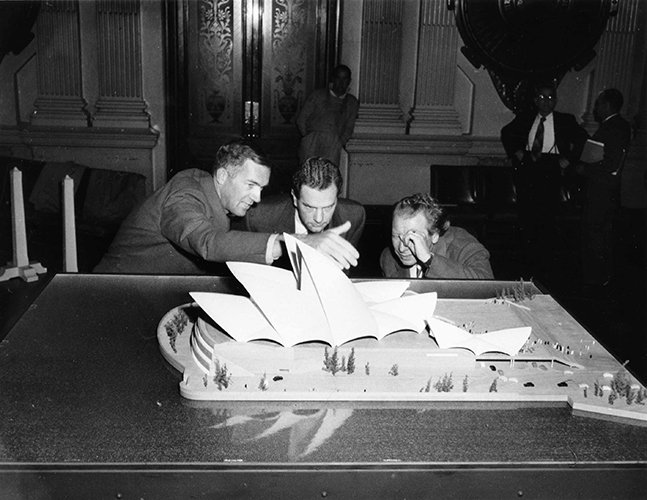On this day: Winning design for the Sydney Opera House revealed

ON THE AFTERNOON of 29 January 1957, in a ceremony at the Art Gallery of NSW in Sydney, Premier Joe Cahill announced the winner of the competition to design ‘a national opera house’. They chose a young unknown 38-year-old Danish architect named Jørn Utzon whose design beat more than 200 other entries, with the judges writing that his design presented “a concept of an Opera House which is capable of becoming one of the great buildings of the world”.
Despite this high praise, Jørn’s bold, sculptural vision was nearly consigned to the pile of rejects. According to The Opera House Project, a joint venture of the ABC and the Sydney Opera House Trust:
“There is no precise record of how the winning design was finally chosen, and accounts vary as to the extent to which Eero Saarinen was insistent on the winner. A popular story is that Saarinen was underwhelmed by the already shortlisted entrants, and pulled Utzon’s entry out of a pile of rejected schemes, exclaiming that it was easily the winning design. The anecdote is likely to have at least been close to the truth.”

Jørn Utzon (left) shows two others the winning Opera House design. (Credit: State Library of NSW)
The winning design thrilled the architecture profession – but the public reaction was fairly mixed. Bemused letter-writers to The Sydney Morning Herald described it as ‘a Danish pastry’, an ‘armadillo’, ‘a disintegrating circus tent’, ‘the Loch Ness monster’ and ‘an insect which has crawled out from under a log’.
Surprisingly, Jørn had never visited Sydney, but his life experience influenced his design choices. His father was a naval architect and director of the local shipyard, and Jørn himself was a keen sailor. Jørn studied maritime charts of Sydney’s harbour and devised a striking scheme reminiscent of Sydney’s sailboats.
But his inspiration for the final roof design came not from billowing canvas, but the segments of an orange. This fact has been in dispute for some time but was confirmed by the architect in The Sydney Morning Herald in 1992.
Jørn’s travels in Mexico also influenced his concept. He envisioned the Opera house sitting atop a wide horizontal platform, like those at the ancient Mayan ruins of Chichén Itzá.
For his efforts, Jørn won £5000. He was eventually commissioned as the chief architect for the ambitious project, and moved his family to Sydney.
RELATED: 40th Anniversary of the completion of the Sydney Opera House
Opera House construction marred by controversy
The immense building project commenced on 2 March 1959 – a premature start given the logistics and technical details had not been finalised, but politics dictated that the project should get underway before the tide of public opinion turned. The initial budget was $7 million, and the projected completion date was 26 January 1963.
But things didn’t go to plan. Jørn’s concept was so complex that it took at least six years to find an engineering solution for his curve-filled design. As the technical challenges and building delays mounted, so too did the cost of the project, and the frustration of the people (and politicians) of Sydney.

The construction of the ‘shells’ of the Opera House was complex and required the development of innovative techniques. (Credit: Sydney Opera House Trust)
Tensions grew with a change of government in mid-1965. The new Liberal Minister of Works, Davis Hughes, was a vocal opponent of the Opera House project. He questioned Jørn’s schedules and cost estimates, and even attempted to alter the architect’s designs. The working relationship completely collapsed in early 1966, when Davis withheld payments from Jørn, forcing him to resign as chief architect.
Despite protests attracting up to 1,000 people, Jørn was not reinstated. Instead, the government appointed a panel of architects to complete the interior of the Opera House, who significantly altered Jørn’s plans. Jørn and his family hastily left Australia, and he never returned.
The Sydney Opera House was finally opened by Queen Elizabeth II on 20 October 1973, after 14 years of construction at a cost of $102 million. Jorn did not attend the ceremony, nor was his name mentioned.
Sydney Opera House becomes a world-famous icon
As the memory of the Opera House’s controversial creation faded, Sydneysiders and Australians have come to love this artistic monument. Today, the Sydney Opera House is a celebrated Australian symbol recognised around the world.
“It’s one of the most important buildings in the 20th century,” says architecture critic and author Elizabeth Farrelly. “It’s a miracle it was lobbed into Sydney, which really had no idea what it was getting.”
RELATED: Birth of the Sydney Opera House
The architectural significance of the Opera House extends beyond its curved facade. Innovative and new techniques were developed to realise Jørn’s vision, and it was one of the first building projects to use computer-aided design.
“We tend to think of it as a postcard but it’s more interesting than that,” says Elizabeth. “It’s an extraordinary technical feat of getting something to stand up, and of using technological know-how in the service of imagination – something that I think is still quite rare in Australia.”
In 1999, the NSW government reconciled with Jørn, and commissioned him to develop a set of Design Principles to guide future changes to the building.
“It was an irrevocable tragedy losing Utzon and his incredible explosion and bubbling up of genius,” says Elizabeth. “The Opera House is a symbol of a cultural clash between the sophisticated design culture of Scandinavia and the snakepit of crude Sydney politics.”
Jørn Utzon passed away in 2008 at the age of 90. While he never visited his completed masterpiece, he had lived to see it awarded World Heritage status in 2007.
READ MORE:




